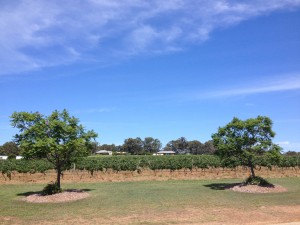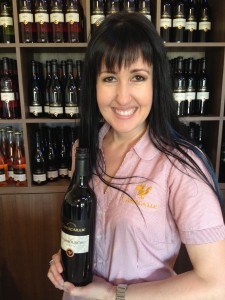Is Australian Chambourcin The Best?
Chambourcin is a very popular grape for winemakers in less extreme temperatures zones of the Midwest. However, like many hybrids, the grape isn’t high in tannins and once vinified into dry red wine, it can be plagued by an overly vegetal taste.
I haven’t tried a huge number of Chambourcin wines – possibly fifteen to twenty – but even to a fan of hybrid grapes like me, many were simply too vegetal, or just unpleasant. Obviously I haven’t found enough really good Midwest Chambourcins yet!
Over Christmas, in Australia, I was very surprised to find that about 15 wineries in the Hunter Valley – more famous for its Semillon and Shiraz – grow Chambourcin, some of them since the mid-1980s. According to the law of averages I probably shouldn’t have encountered a really good Chambourcin the first time I tried one in Australia – but I did.

Capercaillie’s vineyard in the Hunter Valley, Australia. The Chambourcin is at the back near those houses!
The best Chambourcin I’ve drunk so far was made in the Hunter Valley by Capercaille Wine. I sampled it in their tasting room and drank it again at my family’s home.
Tina Martyn, the tasting room supervisor describes the aroma: “It smells particularly earthy, barnyard and smokey too, with deep crimson and purple hues.”
To me, there were no “off” vegetal flavors. The fruit was forward, plummy, but not overly fruity; some tannins were in evidence. There was acid and the impact was a wine of medium body with plenty of mid palate. It was a nicely balanced wine.
When I told a Midwest winemaker about this Australian Chambourcin revelation and suggested, a little cheekily, that maybe there was something to learn from what the Aussies are doing, he looked at me amazed and said, “But the terroir, the growing conditions and the climate – they’re so different over there!”
Or down there. They are, but lets quickly compare the Hunter Valley with Missouri:
Missouri Climate: Generally humid continental
Hunter Valley: Sub-tropical with maritime influences
GDDS in the Hunter Valley: About 2000
GDDS in Hermann, Missouri: Often higher than 3000
Missouri ‘Rhineland’ soils: Includes rocky residual, various silt loams with varying clay and silt concentrations
Hunter Valley Soils: Include sandy alluvial flats, deep friable loam, silty loam and alkaline clay loam.
Maybe some winemakers have thoughts on those differences? Are they critical? Perhaps the coastal location of the Hunter Valley is very important here?
Here’s some more interesting reading, this time a juice analysis for this Australian Chambourcin, from Capercaille’s winemaker, Peter Lane:
Typical final juice analysis: 22.5 — 24.5 Brix.
pH range: 3.45 — 3.55
TA range: 6.8 — 7.5g/L
Lane said these figures “can vary significantly” but suggests these results will get a balanced Chambourcin wine from their vineyard. I’ve no experience making Chambourcin, but from a few comparisons to Midwest juice figures that can be found online, e.g. on the Missouri State University website. The Brix and the pH for this Hunter Valley version seem to be a little higher and TA seems to be lower than Missouri.
Capercaillie spur prunes these vines and, “Our yields tend to be small, picking 4.7 tonne & 4.9 tonnes from the last two vintages from the 2 acre vineyard,” added the winemaker.
He also said they ferment their Chambourcin juice a little cooler than their vinifera red – at between 71F and 75 F. The fermentation usually finishes in 5 days, during which time the juice is racked and returned about 5 times a day. That sounded like a lot of racking to me!
Lane innoculates for malolactic fermentation (MLF) and “the wines are finished MLF in 2-3 weeks. In the last two years I have not had to acid adjust post malo,” he added.
In terms of vineyard practices, Martyn, the tasting room supervisor and a graduate of winemaking studies, hinted that they might pick their Chambourcin relatively early. Could that be a key to making a nice Chambourcin, at least in Australia?
She said they often get rained on during harvest and “the Hunter Valley is not of high elevation so we need to grow varieties that ripen early and our fruit is picked quite early so as to avoid downey/powdery mildews and grey rot.”
For this particluar 2013 Chambourcin vintage, here’s how Martyn described the weather: “We had an almost 5 month drought with minimal rains on the lead up to vintage. This made for very small yields and high concentration of primary fruit flavours. We did receive some rain on the back half of the vintage — very end of the harvest for our reds but the fruit was virtually unaffected.”
The wine spent 13-14 months in 1 and 2 year old French oak. The winery suggests it can be drunk now or cellared for up to seven years.
So that’s how a very nice Chambourcin is made in Australia!
See related story: Edg-Clif Farms: Chambourcin Specialists
Danny Wood is a Kansas City based Australian journalist who works at Belvoir Winery in Missouri. He was smitten by wine (and his American wife) while living in Spain, reporting for BBC News.





The higher concentrations of herbal notes in Missouri Chambourcins are probably due to picking too early and not practicing leaf thinning early or heavy enough (methoxypyrazine management). The real question I have for the Aussies is what kind of trellis system are they using? In Missouri Chambourcin is typically grown on a high wire cordon trellis system.
Also what kind of planting density (vine x row spacing) are the Aussies using? I believe solving questions like these in relation to vine vigor will help solve the herbal flavor and aroma issues common to Midwestern Chambourcin
Thanks for your comments Jed. I’m hoping Capercaille Wine will answer soon…in the meantime, in line with what you’re saying, I just came across this quote in my VESTA course lecture notes from Australian viticulturalist, Brian Croser: ‘Differences in canopy management can produce more significant quality differences than the difference in temperature summation between regions”
Danny
(using Mark’s log-in)